Imperial Cycle – Neutral

Although not a faction, the Neutral cards are the most important in any pack. They are playable by everyone and have the greatest potential impact on the meta. For the Imperial cycle a few stand out.
The Imperial Palace is seeing play in almost all decks due to the importance of the imperial favor. Everyone has some card they want the favor for, even if it is just Censure, and at the very least if prevents your opponent from powering their own favor reliant cards.
Action denial got some extra options with Finger of Jade and Censure available to everyone. To add to that, Goblin Sneak provides a way to limit your opponents options by removing their fate while the targeted discard of Policy Debate has been incredibly popular and is seeing play in a lot of decks.
This set also introduced a few cards that significantly alter the way the game is played. Waning Hostilities, Way of the Chrysanthemum, and Mono No Aware all turn some of the basic core mechanics on their head in some way and have the potential to be meta defining.
The set also introduced 10 new neutral provinces doubling the existing number. Of these 2 are keeper/seeker locked while 5 require a specific element to play. These option options, provide greater variety and make the role choice even more significant.
Characters

Goblin Sneak is a 2 cost conflict character with 1 military, — political, and 0 glory. This is the first Neutral conflict character we’ve seen, so it is worth remembering that there is a limit of 10 conflict characters in the conflict deck. When the Sneak comes into play, he takes 1 fate from your opponent’s pool and places it on itself. The cost of 2 fate for a 1 military and — political character is poor, but you do get to remove 1 of your opponents fate and add it to the Goblin Sneak. If your opponent is on 1 fate, bringing them down to 0 significantly reduces the number of conflict cards they can play. If your Phoenix opponent is on 2 fate and you are about to win an unopposed conflict, dropping this sneak into play will stop them playing Display of Power(also remember that during a conflict when you play a conflict character you can choose to play them into the conflict or at home).
For those new to the game, the Shadowlands trait may not mean a lot but players of the old game are super excited to see this trait on a card. The Shadowlands is the area to the south of the Crab wall. That area is corrupted by evil, it is the home of unnatural monsters that want nothing more than to corrupt and destroy the Samurai of Rokugan. There are some players who will never play Shadowlands cards in their decks no matter how good they are, for fear the story team will see and decide that clan is somehow corrupt. There are also some players who get as many Shadowlands cards into their deck as they can, either because they love the bad guys or because they feel it will make the story more exciting.

Throughout the Imperial cycle, this has been one of my favorite cards. In every pack, I could point to the Imperial trait on a card and say ‘Seppun Ishikawa will love this card!’. Ishikawa is a 3 cost unique Bushi with 2 military, 2 political, and 2 glory. For each other Imperial card you control he gets +1 military and +1 political. There are a bundle of Imperial cards right now, notably the magistrates for each clan, the cheap neutrals from the base set, and some holdings. Of those, many clans will play their magistrate. Players will have the option to play the neutral characters such as Otomo Courtier and Seppun Guardsman, but as the card pool has developed they are seeing less play. Imperial Storehouse has always been popular and The Imperial Palace has many fans. For the most part, these are all 1 shot cards where you have them for just 1 turn. Looking at it this way, it’s likely Ishikawa will normally be 3 military and political skill with the occasional turn where he goes to 4 or 5 in both skills. Looked at this way, he might not be worth playing but he sure is cool!
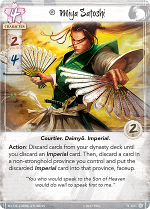
This 4 cost unique Courtier has 2 military, 4 political, and 2 glory. Those are actually decent stats, although in retrospect I haven’t always seen it that way. As an action, you can discard cards from your dynasty deck until you reveal an Imperial card and then place that Imperial card into one of your provinces face-up. If you only play Satoshi that will let you get an extra copy to play then turn he comes into play, allowing you to discard for an extra fate. Then on the next turn, you can do the same. There is a pretty good chance that strategy would mill your deck, but if you can afford the 5 point honor loss Satoshi will always be able to get an extra copy of himself. This might be a use for the Togashi Mendicant ability, checking the top 3 dynasty cards for an Imperial card before deciding to trigger Satoshi. Assuming you include other options, there are 7 neutral Imperial cards available: Imperial Storehouse, Miwaku Kabe, Miya Mystic, Otomo Courtier, Seppun Guardsman, Seppun Ishikawa, and The Imperial Palace. Any of the cheap characters essentially provide an extra province of production. The Storehouse is a free card. The two provinces are of note, as one criticism is how you cannot choose which province you drop them onto. With Satoshi, you can. This is especially pertinent for Chisei District and Hito District which can be dropped onto the province of your choice. Similarly, this allows the Crab get easier access to their own Imperial unique province Karada District. Each of the magistrates from the cycle are Imperial, so each clan has their own copy. Finally, Seppun Ishikawa is Imperial and will benefit from Satoshi’s trait and any other Imperial cards Satoshi should manage to fish out. Alternatively, rather than fishing for Imperial cards you can use Satoshi to get cards into your discard pile. This is relevant for Crab with Rebuild, Lion with Kitsu Spiritcaller, and Unicorn with Cavalry Reserves all of which can fetch cards from the dynasty discard pile. All this in mind, Satoshi looks like a pretty awesome card that will see play, even if some of the decks get quirky.
Holdings
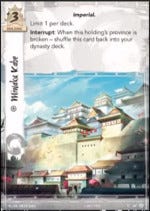
This holding has +3 province strength, which appears to be its main purpose. When the province is broken, you can shuffle this holding back into your dynasty deck. I’m going to go as far as saying this is a terrible card. The best chance for it to see play is with the Crab card Rebuild to pull it out of your discard pile. It does also benefit Seppun Ishikawa as it is an Imperial card. On the downside, as a holding, it turns up in a random province. You don’t get to decide which province, so it can randomly turn up in a broken province and be wasted. It can also turn up in your best province and your opponent will never attack it as they can instead attack another province. If it somehow turns up in your worst unbroken province it will encourage your opponent to attack another province, but at the same time every turn it remains there denies you an extra dynasty draw that could be useful. Right now my best hope is that this card isn’t designed for competitive play and instead is part of a fun multiplayer or event style deck.
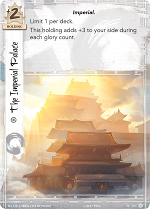
As the rules reference specifically refers to 3.4.1 (to determine the Imperial Favor) as a glory count, the Imperial Palace is a way to contest the Favor strongly, even if you’re not winning via rings and standing glory. The +2 province strength helps with defense and the Imperial trait does help Seppun Ishikawa. As The Imperial Palace is restricted 1 per deck, you’re not going to be able to depend on it to turn up at the right time. If you’re playing the Crab card Rebuild, this will improve slightly, allowing you to retrieve a discarded copy in the last action window of the conflict phase, just before the Imperial Favor is decided. With cards like Censure, the Imperial Favor has become increasingly important. The Imperial Palace helps grab it, but, without Rebuild, might be too unreliable to see play.
Update: This card is making its way into almost every deck, the Favor is that important.
Attachments

The Finger of Jade is a 1 cost attachment with +0 military and +0 political. When a card ability targets the attached character you can sacrifice the Finger to cancel the effects. For decks that have a wide board this isn’t going to offer much, if your opponent can choose from multiple targets they will just choose another target. Decks that have a tall board, ones like Dragon that invest in a ‘super unit’ are going to love this card. Decks like Phoenix who have key characters that they want to keep safe, such as Isawa Kaede or Shiba Tsukune, are also going to like this. The Jade Finger provides amazing protection from kill actions like Noble Sacrifice, and I Can Swim. It also prevents bow and send home actions that might turn the tide of a conflict. Notably, due to the timing, this will not stop cards like Way of the Crab or Court Games which target as part of the effect rather than the cost.

Getting to draw the best card out of the top 5 of your conflict deck is a fantastic effect. Having to bow a courtier for it is painful. Typically cheap characters don’t stick around, an Otomo Courtier normally is bought for 1 fate and leaves at the end of turn. If you attach the Missive to the Otomo Courtier, you end up paying 1 fate, playing a card, and bowing 2 political skill to draw that card. At the end of turn, both cards will leave play. A greater investment leaves the Courtier vulnerable to Assassination. More expensive characters will stick around longer allowing the Missive more uses. If you play the Missive on a big character such as Asahina Storyteller you’re losing out on much more skill, 4 in this case. Other characters need to be in conflicts for their abilities, Kitsuki Investigator, for example, would best use the Missive in a political conflict where he can still use his ability. There are some good options that strike a balance, the Favored Niece, another example, is only 2 military and 2 political skill and really is played for her ability which will still work while bowed. So, while the effect is great it needs to be balanced against the cost and investment. Scorpion dishonor decks may get the most use out of this card, allowing them to bid 0 and draw into key parts of their dishonor deck. Cheap courtiers such as the Bayushi Manipulator may actually be worth investing in to draw out that Assassination.
Events
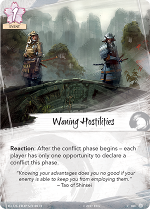
This is a super interesting card that opens up unexpected approaches. Decks that focus on one conflict type only can focus on just winning that one attack denying their opponent a second attack. Decks that are interested in defending only have to repulse one single attack. It lets you mitigate a bad turn, making sure you lose no more than one province. It is likely this card is best off when you are going second, allowing you to decide how best to defend knowing that you’re single attacking conflict will be the last of the phase. The covert keyword is even more effective, as targeted characters will never get to defend.
Every clan can play this with some success. Some have already started talking about the first turn pass strategy where no characters are made turn 1 instead playing Waning Hostilities and cards like Charge! and Mirumoto’s Fury to protect that one province then have an explosive turn 2. Phoenix might be able to get some extra mileage out of this. With Display of Power they can assure they get all of the rings for the turn. Harmonize stops an attacker and leaves them only able to defend in the conflict type of the Phoenix players choice. This isn’t a card that helps you win conflicts, instead, it changes how the round works. It is an exceptionally cool card that will need some testing and could open new ways to play the game.
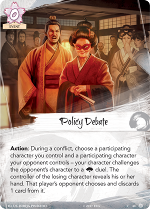
This is a card that goes straight into any clan that can muster a decent amount of political skill. Winning duels isn’t particularly hard, with a reasonable amount of setup even when you lose a duel you gain honor and come out ahead. This card, already dubbed ‘rap battle’, allows you to pick both competitors in the duel letting you setup very unfair pairings. The winner gets to look at their opponent’s hand and discard 1 card from it. Seeing what your opponent has gives you knowledge, getting to discard a card removes their options. As you’re playing a card to take this action, both you and your opponent are down a card each but they’ve lost their best card. There are times when you are less interested in the duel effect and more interested in the duel itself. The Kakita blade is a way for you to gain honor if you win, if you are ahead by 1 at the start of the duel, if you choose to bid 1 you will gain 1 honor either from winning the duel or from your opponent having a higher bid. This also gives the Scorpion an opportunity to meddle with their own dial to set up cards like I Can Swim. Fantastic card.
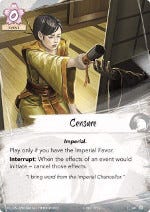
We were lucky enough to get the preview for this card and some of our ‘hot takes’ are available here. Voice of Honor and Forged Edicts are defining cards for the Crane and Scorpion respectively, and so far both clans have been very successful. As Censure is action cancellation, by itself, it doesn’t do much. If you are behind in skill it isn’t going to help you turn it around. If your opponent doesn’t have any good events to cancel it will sit as a dead card in your hand. Luckily, events are a cornerstone of the current environment, so Censure will always have a wealth of targets. The only real issue with this card is having the favor to play it. Turn 1, neither player will have the favor until the end of the conflict phase, so while it can have some niche uses, normally on turn 1 Censure isn’t useful. In the core environment getting the favor was a nice bonus for a good turn. In the Imperial environment, we can expect to see the imperial favor more hotly contested with characters ready at the end of the conflict phase to contest with their glory. This may give the Phoenix clan an advantage with their stronghold Isawa Mori Seidō. As a neutral card, Censure has the opportunity to impact the event environment. If it becomes commonly played cards with high fate costs such as Cavalry Reserves and Blackmail may become overly risky.
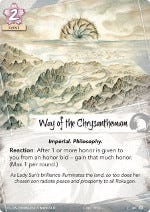
Honor running has not been viable despite the best efforts of many players. Hitting 25 honor just hasn’t been reliable enough. Way of the Chrysanthemum changes that. After you gain 1 or more honor due to an honor bid, you can play this 2-cost event to gain an equal amount of honor. Bidding 5 has been a typical opener for most clans on turn 1. If your opponent has two fate ready, can you afford to bid 5 anymore? They could bid 1 and play Way of the Chrysanthemum to gain a total of 8 honor that turn! With most players starting on 11, that puts them to 19 honor with only 6 left to gain. Even worse, they could bid 0 with Contingency Plan and gain 10! An air conflict and a few honored characters leaving play and they win. This will be at its most effective in clans with dueling and card draw. Card draw will help make up for the constant bids of 1 during the draw phase. Dueling provides more opportunities to trigger the effect, and if the opponent always bids 1 then all the duels are sure things. If your opponent does bid 1 of course, this card is pretty much dead. This is a card that forces you to seriously think when you see those 2 fate at the start of the draw phase. We’ll only know whether it makes honor a viable strategy once we get it out into the environment.

Earlier we spoke about how Waning Hostilities changed how the game was played. Mono No Aware is equally impactful. A 3 cost event it removes 1 fate from each character and lets you draw 1 card. Only 1 can be played per turn. This favors decks who invest minimal fate in characters instead of letting them leave play and punishes those decks that try keep characters around. It can be played in the conflict phase to make characters vulnerable to effects such as Ring of Water or Mirumoto Raitsugu. It can be played after the last conflict, leaving the surprise for your opponent as late as possible. It can be included in a deck as a core element where you try play it every turn and put no fate on your characters. Alternatively, it can be used situationally, playing the card only when windows appear. Crab can make exceptional use of it, keeping characters around with Iron Mine and Reprieve while their opponent’s characters leave play. This card has the potential to shift the environment, changing how decks are played. At 3 cost, however, it is quite expensive, and like any expensive event, it is especially painful when it is canceled by Voice of Honor, Censure, or Forged Edict.
Provinces
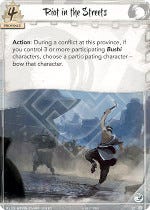
This is a 4 strength water province. As an action, if you have 3 or more Bushi characters, you can bow a participating character. The water provinces currently change something, either Elemental Fury changing the ring type or Rally to the Cause changing the conflict type. Riot in the Streets adds an extra option, an action that will be reusable every turn. This makes it a great province to defend for the clans who have enough Bushi to meet the condition. This means Lion, Crab, and Unicorn. All of these clans have the Keeper role, meaning they will need at least one of each of the elements when picking provinces. The other clans do have Bushi but are unlikely to run the same amount as those 3 clans do. Lion will probably prefer their stronghold province The Art of War as it improves their aggression. Unicorn will be able to move a character into the province if the conflict is military, this will help them hit the 3 Bushi requirement even if the moved character is bowed. Again, Unicorn have a water province in clan Endless Plains, unlike with The Art of War there is more scope for Unicorn to opt for Riot in the Streets. The last clan Crab, have an earth clan province, so where normally Ancestral Lands or Entrenched Position would be the stronghold province there is the option to instead have Riot in the Streets. This will make that last province a real tough nut to crack and will leave Defend the Wall out to trigger earlier in the game.
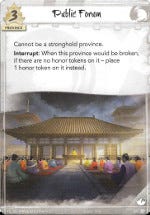
Earth provinces in the core environment typically ended up underneath the stronghold relying on the 5 province strength. Public Forum is different, it cannot be placed under the stronghold and has a small province strength of 3. Just before it is about to break it can take an action to prevent it from breaking. This is a once only option and the next time the province will break for good. In this regard, Public Forum is similar to Rally for the Cause. Rally has been the most popular water province in the tournaments run so far, it shifts the conflict often protecting itself from destruction the first time. Public Forum is a second option, slowing down the destruction of your provinces and giving more time for you to push towards your own victory. This also constitutes a ‘safe’ province in the same manner as Feast or Famine with similar risks.
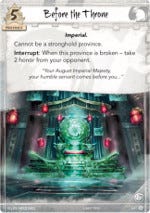
This is an air province that cannot be a stronghold province. At 5 province strength, it is the highest of the air provinces. When the province is destroyed, you can take 2 honor from your opponent. This helps decks seeking to win by honor as well as those looking to dishonor their opponent. As an air province, it competes with Fertile Fields and Manicured Garden as well as the Scorpion and Crane provinces Secret Cache and The Art of Peace. A Scorpion dishonor deck would struggle to decide which option to include. The Crane on the other hand, as Seeker of Air, can choose to run both. At 5 province strength, it is a little easier for an attacker to change course and try not to break the province. This might even mean playing attachments and events to boost the defender! Where an honor deck would need to defend to prevent losing that point of honor, a dishonor deck would not need to, making it easier to let the province break and trigger the effect.
The Keeper / Seeker Provinces

This is a neutral seeker only fire province with 3 province strength. During conflicts at this province, each player cannot spend fate from their fate pools. When it is attacked the first time, it will come as somewhat of a surprise to the attack, so it is possible they might be expecting to spend some fate to take the province. On the other hand, it will also come as a surprise for the defender as you have no control over which province your opponent attacks (unless it is the last one). As the province strength is 3 rather than the normal 4, it almost comes as a relief to the opponent that they don’t have to spend fate. On subsequent attacks the attack will know they need to spend fate before the attack and can account for the province, essentially negating it. It competes against Night Raid and Meditations on the Tao both of which are more reliable.
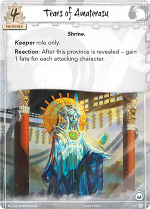
This void province is Keeper only. It has 4 province strength and has a reaction to gain fate equal to the number of attackers. The reaction is similar to Night Raid which discards cards equal to the number of attacks. Night Raid has mixed popularity as it will often just discard 1 card. As a void province Tears of Amaterasu competes with Pilgrimage and Shameful Display. Shameful is considered by many to be the best province in the game. If this was a Seeker province, Tears could compete to be the second province included, but with such high standards, it is unlikely to be played.
The Elemental Provinces
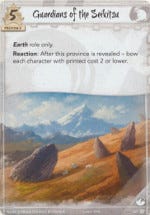
This Earth-role-only province is currently only playable by the Crab clan. With 5 province strength, it is at the higher end of province strengths. The ability is on-reveal and, importantly, is a triggered effect — so the Crab player can decide whether they want to trigger it or not. The effect bows every character with cost 2 or less, across the board, whether in the conflict or not. This bears repeating. When activated, this province bows every 2-cost and cheaper character in play. This is a game-winning province. Sitting on the stronghold province, it defends itself and sweeps the board of defenders, allowing the Crab to declare their own attacks to finish the game. Any Crab characters bowed can be sacrificed to effects such as the Steadfast Witch Hunter, turning useless Crab troops into resources while the opposing characters remain stranded. Add in covert effects such as Hiruma Skirmisher to prevent any remaining characters from assigning to defend, and a game could easily swing to the Crab.
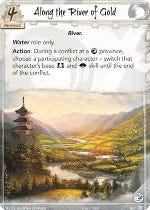
This Water role only province is 4 province strength. Currently, only the Phoenix can play it as they have the Keeper of Water role. While this province is revealed, you can use its action to switch the base military and political skill of a character at a water province until the end of the conflict. This ability it identical to that of Bayushi Yunako who is a powerful Scorpion character. In contrast to most provinces, this ability can also be used at other water provinces. So if Along the River of Gold has been revealed and survives the attack, the ability would be useable at the opponent’s water province (assuming it had not already been used this turn). Provinces that defend themselves, as this one does, are particularly notable. This would replace Elemental Fury or Rally to the Cause for the Phoenix both of which are once-off effects. Although it might be a hard sell to move away from Elemental Fury given the recent water ring focused cards, having an ability that could be used every turn and in effect acts as a mini Rally to the Cause might be too good to pass on.
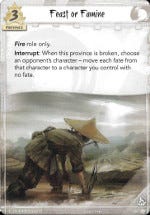
Feast or Famine is a 3 province strength fire province that can only be played by clans with a fire role. Currently, the Dragon and Lion clans have fire roles. When the province breaks, the defender can move all the fate from an enemy character to one of their characters with no fate. As a break effect, this is a one-shot only effect and if you don’t have a character with fate when it breaks the effect cannot be triggered. The effect is massive and will probably be a 2 fate swing from their best character to one of yours who would have been leaving. As this only has an effect when broken it runs the risk of being a ‘safe province’. Dishonor decks don’t want to break provinces, they just want to win air and fire conflicts. As long as they don’t accidentally break the province, they can continue to win rings off it. Dragon will be able to run an aggressive fate denial deck with this and meditations on the void. This will mean abandoning their clan province Restoration of Balance. Dragon may need to adjust their play style to make sure they have a character with no fate ready for the effect. The Lion on the other hand just need to slot this into provinces, they already have plenty of characters coming into play without any fate staying around for just a turn.
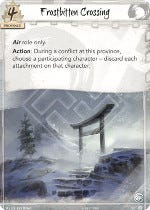
Frostbitten Crossing is an Air role only, meaning only the Crane clan can play it. It has 4 Province strength. During a conflict at this province, you can take an action to discard all attachments on a character. As attachments like Fine Katana and Ornate Fan are in almost every deck and are often relied on to help take provinces, this province does help protect itself. As the ability is an action rather than a once off reaction, every turn this province is not taken is another opportunity for the ability to be used again. This is competing against Fertile Fields and Manicured Garden which are reliable resources useful against everyone. Frostbitten Crossing isn’t as reliable, but does help protect itself and has the potential to have a massive effect especially against Dragon decks who like to form a Deathstar unit. This definitely is a card worth consideration in Crane decks but will require some testing in the environment to see whether it pushes out either of the other two air provinces.
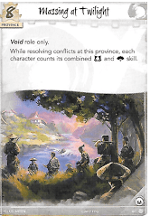
This void role only province has 8 province strength which seems like a big boost but characters add their military and political skill to conflicts at this province. For some clans who primarily focus on one skill such as Lion, Scorpion, or Unicorn and maybe Crane and Crab that is a big drawback. For other clans like Dragon and Phoenix who have more balanced stats, that is a big boost. Currently, Scorpion and Unicorn have void roles. Dishonor and cards like Fiery Madness which inflict penalties are twice as good as normal, which has been pointed out as a reason for Scorpion to run this, but it would appear the boost for those cards is out-weighed by the penalty inflicted on Scorpion defenders. Currently, this doesn’t seem like a good option for either of the clans that can play it. Ignoring the cards effects, it already competes with some of the strongest provinces in the void slot. Even with a if Phoenix were to get the Seeker of Void role in the future, they are unlikely to play it favoring Kuroi Mori and Shameful Display. Dragon might consider it as a stronghold province if they were to take a keeper of void role again, till then it’s a fun card that goes into the binders.
Conclusion
The Imperial cycle is already pushing what we know about this game and how we play. It will take some time before we fully understand the options cards like Waning Hostilities, Way of the Chrysanthemum, and Mono No Aware provide. The new role-based provinces increase the differentiation between the different roles and will make next years shake up even more traumatic as players used to some of these cards suddenly lose access to them.

3 Replies to “Imperial Cycle – Neutral”
I haven’t tried it myself, but I’ve recently seen some event-heavy Crane decklists with Blood of Onnotangu under the Stronghold, on the basis that Crane don’t spend Fate on Events during Conflicts at their Stronghold.
Great point! I’m probably more negative on it than I should be because I love Mirumoto’s Fury when defending.
About Blood of Onnotangu, it can be used as a counter against decks that rely heavily on charge, conflict characters and similar efects. But I think maybe it is not enough and not the best. Based on this idea, I have tried a crane deck with voice of honor, censure, honored guest, ageless crone and Blood, and the province seems to me the most replaceable (in that build). I still wear it as the replacements, though reliable are neither impressive, but I could change anytime.